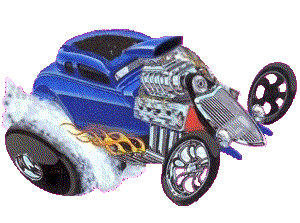my hobbies
Vintage Computers
There's few things that you can probably attribute to your older brother, but I have one that's kind of special. I first started in electronics around 1970 when my late brother, while away in the Air Force, bought me one of the Heathkit Electronics lab with these little red blocks that resembled alittle bit like Legos and contained individual components inside (which I had to assemble myself--uugghh--). These would interconnect with wires, much like the breadboarding kits today. They would snap into place on a flat white plastic board which resembled a large piece of Lego--with all the flat round pegs). They came with two of these blue plastic control panel consoles with a sloped front - just like out of a sci-fi movie. This contained all the basic parts already inside, such as the speaker, analog meter, morse code keyer, Tuning knob, signal lamp, etc.
You could layout your electronic circuit much like a schematic on paper and wire it all together. I became so nervous when I broke one of the legs on the transistors and didn't tell my brother. I thought the whole kit must have cost a fortune and the one transistor must have be worth big bucks. I just ignored it until he noticed when one of the projects that I wired operated in a mysterious manner :)
Then later on I began discovering computers while growing up on Long Island around 1973. I started building discrete TTL logic gates using surplus transistors from an old electronics store, Edlie Electronics, out in Levittown, Long Island. I can blame my older brother for convincing me to do this. This was in the early 70's while in Jr. High school and reading the early articles about microcomputers in the magazines, Popular Electronics and Radio Electronics.
Thereafter, we found that we could get TTL chips so cheap from Poly Paks -- we bought a whole lot of parts from them, I actually still have some left over. Lafayette Electronics was another cool place that was in the local area where we could get parts on short notice. Shortly after that, I worked on building a microcomputer using discrete TTL logic--it was a real chore to wire this-- with just a few bytes of ram and it's own microcode. It was very limited and crude as compared to the new Intel 8080 processor which was released during this time. I programmed this using only a few switches and Leds.
Not long after that, the computer stores started popping up in and around New York City, Computer Mart was the popular place to visit back then (in Manhattan). They were showing the new microcomputers of the day--in 1975--, I was drooling over the Compucolor I, it costs about 5 times as much as the Altair 8800. Not long after that there were a slew of other microcomputers available in the stores. We built a homebrew S-100 machine from scratch using parts we bought from the different electronics stores. The power supply was a beast. not long after that we bought out first kit, Altair 680b (still have it). During high school, I bought the Netronics ELF microcomputer kit and built this as a project for our Electronics class.
Then me and my ol' buddy would go visit the Computer shows every year in Manhattan at the Jacobs convention center to see all the latest stuff. It was great to see all the new machines that came out each year during the 70's. For some reason, it was way better watching and playing with all of this than the school computer we had - but it was still fun to use that on too. There was a Honeywell 1646 Timesharing minicomputer system that we used for all the computer science classes in high school. This was a great machine for it's day and we had several different terminals to use -- including the ASR33 teletype, DEC Writer terminals, TI 505 terminal , and even a Hazeltine terminal.
